The Wildlife Around Deerfield High School
December 13, 2022
The territory around Deerfield High School is home to a variety of different species of birds, insects, and other organisms. DHS science teachers are knowledgeable about the local ecosystem, and many of them work closely with their surroundings in the classroom. Mr. Stafford, who has studied biology, spoke about common flora in the Prairie State. “We have a lot of different wetlands, deciduous forests, small patches of conifers, and different types of trees that produce cones,” he said. Speaking about the specific terrain around Deerfield High School, biology teacher Mrs. Newman explained, “Prairie Wolf Slough located nearby off of Half Day Road is a type of wet prairie surrounded by oak woodlands. So we have wetlands, prairies, and woodland ecosystems around the area of Deerfield High School.”
American Crow
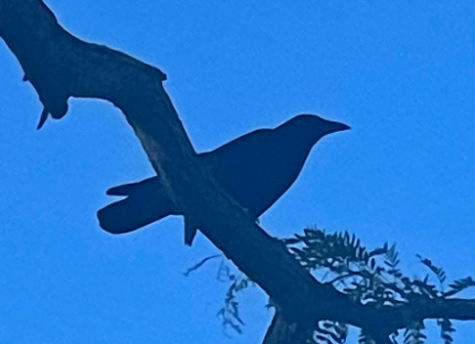
The American Crow (Corvus brachyrhynchos) can be found around the high school, especially in the Courtyard in the early morning. With an average wingspan of around three feet long, they are noted for their impressive size and powerful flight. See this crow take off from the ground:
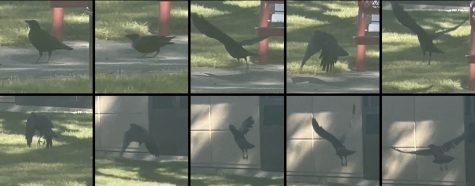
Mrs. Newman described the migratory habits of these passerine birds. “Crows tend to overwinter in the Chicago area, seeking shelter and resources along Lake Michigan as needed,” she explained. An opportunistic feeder, the American Crow feeds on a wide variety of insects, worms, fruits, and even smaller birds. The size and deep ebony plumage of crows are also associated with ravens. Although the two may appear similar, there are several key differences between crows and ravens. Whereas crows have a fan-shaped tail, raven tails appear wedge-shaped due to their elongated middle feathers. Additionally, crows make a consistent cawing sound, while ravens are known for their dark and raspy croaking call.
Canada Goose
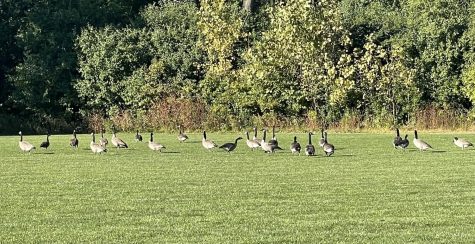
The Canada Goose (Branta canadensis) is most frequently found traveling in flocks. Canada geese like these are identified by their long, slender necks, as well as black and white coloration on their heads. “Strictly from the name, you may expect Canadian geese to emigrate back to their country of origin, but they actually breed in both Canada and the northern United States,” Mrs. Newman described. Large flocks of Canada geese can be found in open expanses such as the Back 40 field behind Deerfield High School. They are notoriously territorial during their breeding season in early spring, and according to Mr. Stafford, many consider them pests.
American Robin
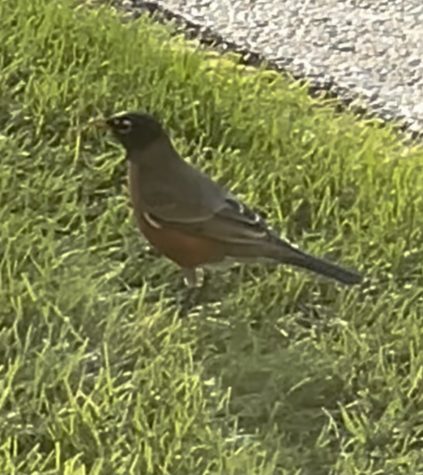
The American Robin (Turdus migratorius) is a type of thrush with a black head and reddish-orange breast feathers. Their dietary needs depend on the resources that are immediately available to them, such as earthworms, various insects, and fruits. These food sources provide the necessary calories for robins before their migrations, which can span thousands of miles long. “Migratory birds such as robins may move to Southern states like Florida or even continue to South America in search of food,” Mrs. Newman said. In the springtime, these robins migrate back in order to breed and hatch their young. The famous cyan color of their eggs comes from a bile pigment called biliverdin.
Northern Cardinal
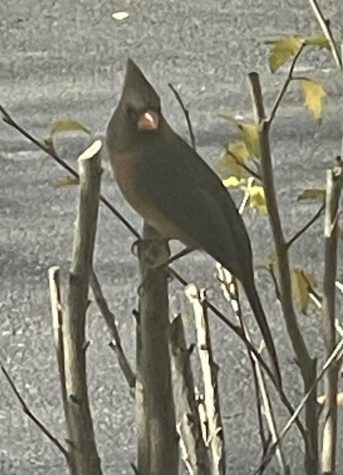
Famous for its color and the pointed feathers on its head, the northern cardinal (Cardinalis cardinalis) is a common songbird that was named for its resemblance to the crimson-robed Catholic clergymen. Male and female cardinals diverge in their appearances—an example of a difference known as sexual dimorphism—and thus it is easy to tell them apart. Male cardinals are distinguished by their bright red hues, whereas female cardinals have dull brown coloration. The vivid scarlet feathers of male cardinals make them more vulnerable to predators, but can also demonstrate attractiveness to potential mates. These birds live in the area year-round, and they have the distinction of being the state bird of Illinois.
Red-Tailed Hawk

With an impressive wingspan that can span over four feet long, the red-tailed hawk (Buteo jamaicensis) is a common bird of prey in North America. Rather than flapping continuously like crows or thrush species, they tend to travel with sustained gliding patterns. Watch this red-tailed hawk soar through the air, tilting its body to take advantage of the wind.
Using their excellent vision, red-tailed hawks soar high above the ground as they hunt their prey. Their diets consist of small rodents such as ground squirrels, mice, and voles, but can also extend to smaller birds, snakes, and frogs. Red-tailed hawks make a shrill and high-pitched call.
Mud Dauber (Nest)
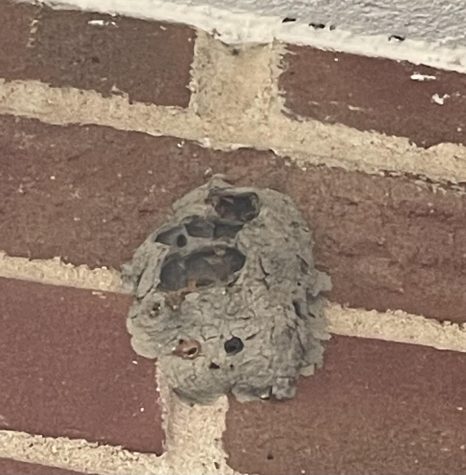
There are several varieties of mud daubers that can be found in Illinois. As their name suggests, they construct their distinctive nests from mud, and several of these can be found under the rooftops outside the DHS Library. “Insects like mud daubers can overwinter here as larvae within their nest cells,” Mrs. Newman described. As nonmigratory insects, they must take shelter from the cold temperatures during Illinois winters. They do not live in large colonies, and instead construct their own nests. Additionally, mud daubers are known to feed on spiders, and they can travel based on environmental stimuli like light. “Some insects orient themselves to the moon to guide their flight patterns,” Mrs. Newman added. As a result, artificial light sources such as porch lights may attract these insects. Although they do not tend to be aggressive, they may sting if provoked.
Eastern Yellowjacket
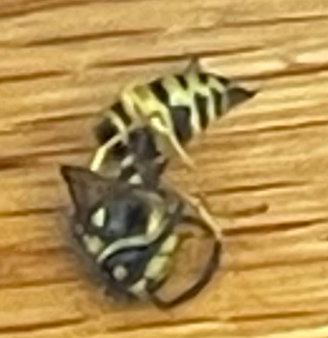
The eastern yellowjacket (Vespula maculifrons) is a species of wasp with a thin build and a black-and-yellow striped body. Around Deerfield High School, they are commonly found around the benches outside of the cafeteria and near the Courtyard. The eastern yellowjacket does not attack unless provoked or if they are defending their nests. Should they sting, they are able to do so repeatedly; however, their stingers are barbed, which can lead to evisceration. In addition, eastern yellowjackets feed on bees and other smaller organisms such as caterpillars and flies. They also consume fruit and nectar.
Black Carpenter Ant
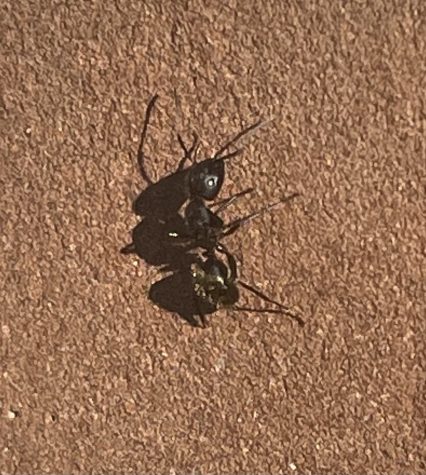
The black carpenter ant (Camponotus pennsylvanicus) is a notably large insect compared to other ant species, reaching up to half an inch in length. They have bold black bodies and yellow hairs on their abdomens, with swarmer ants bearing wings. As opportunistic omnivores, they will eat most anything that they can access, including dead insects, plants, and animals. Black carpenter ants tend to live in wooded areas, chewing wood to construct their nests. Their method of excavating logs and other wood structures gives them their name.
Ganodermataceae
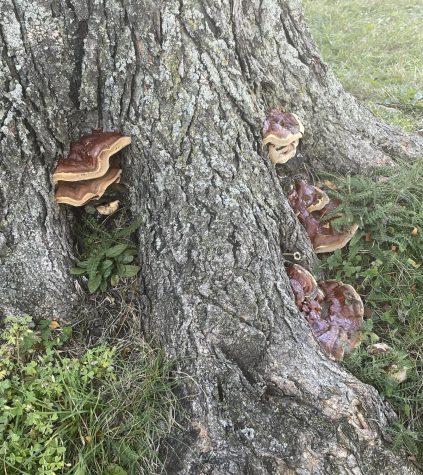
Organisms from the fungi family Ganodermataceae can be found in the Courtyard and outdoor gardens around the school. “I would expect to find the Ganodermataceae fungus living at the base of broad-leaved trees like the large oak tree in our outdoor classroom,” Mrs. Newman said. These fungi are identified by their shelved shapes and tawny brown color, as well as their smooth appearance. Saprotrophs are critical for decomposing organic matter in the carbon cycle. “When leaves drop to the ground, especially in the fall months, the fungi get to work helping to recycle organic matter,” Mrs. Newman explained. Although the flowering body of the mushroom is often the first thing that comes to mind when people think about these saprotrophs, most of the organism is found under the soil, where the elaborate mycelium roots reside.
There is a wonderful variety of wildlife that surrounds us, even in our own backyards. Next time you go outside, see how many species you can identify.

